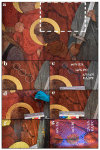Removal of a Past Varnish Treatment from a 19th-Century Belgian Wall Painting by Means of a Solvent-Loaded Double Network Hydrogel
- PMID: 34451194
- PMCID: PMC8399542
- DOI: 10.3390/polym13162651
Removal of a Past Varnish Treatment from a 19th-Century Belgian Wall Painting by Means of a Solvent-Loaded Double Network Hydrogel
Abstract
Polymeric materials have been used by painting conservator-restorers as consolidants and/or varnishes for wall paintings. The application of these materials is carried out when confronting loose paint layers or as a protective coating. However, these materials deteriorate and cause physiochemical alterations to the treated surface. In the past, the monumental neo-gothic wall painting 'The Last Judgment' in the chapel of Sint-Jan Berchmanscollege in Antwerp, Belgium was treated with a synthetic polymeric material. This varnish deteriorated significantly and turned brown, obscuring the paint layers. Given also that the varnish was applied to some parts of the wall painting and did not cover the entire surface, it was necessary to remove it in order to restore the original appearance of the wall painting. Previous attempts carried out by conservator-restorers made use of traditional cleaning methods, which led to damage of the fragile paint layers. Therefore, gel cleaning was proposed as a less invasive and more controllable method for gently softening and removing the varnish. The work started by identifying the paint stratigraphy and the deteriorated varnish via optical microscopy (OM), scanning electron microscopy coupled with energy-dispersive X-ray spectroscopy (SEM-EDX), X-ray diffraction (XRD), and Fourier-transform infrared (FTIR) spectroscopy. A polyvinyl alcohol-borax/agarose (PVA-B/AG) hydrogel loaded with a number of solvents/solvent mixtures was employed in a series of tests to select the most suitable hydrogel composite. By means of the hydrogel composite loaded with 10% propylene carbonate, it was possible to safely remove the brown varnish layer. The results were verified by visual examinations (under visible light 'VIS' and ultraviolet light 'UV') as well as OM and FTIR spectroscopy.
Keywords: FTIR spectroscopy; SEM-EDX; XRD; deteriorated synthetic varnish; gel cleaning; optical microscopy; solvent-loaded hydrogels; varnish removal; wall painting.
Conflict of interest statement
The authors declare no conflict of interest.
Figures











References
-
- Petersen K. Wall Paintings: Aspects of Deterioration and Restoration. In: May E., Jones M., editors. Conservation Science: Heritage Materials. The Royal Society of Chemistry; Cambridge, UK: 2006. pp. 241–265.
-
- Horie V. Materials for Conservation: Organic Consolidants, Adhesives and Coatings. 2nd ed. Butterworth-Heinemann; Amsterdam, The Netherlands: 2010.
-
- Mora P., Mora L., Philippot P. Conservation of Wall Paintings. Butterworths; London, UK: 1984.
-
- Mazzeo R., Sciutto G., Bonacini I., Prati S. Scientific Examinations of the Armenian Church Wall Paintings in Famagusta. In: Walsh M.J.K., editor. The Armenian Church of Famagusta and the Complexity of Cypriot Heritage: Prayers Long Silent. Springer International Publishing; Cham, Switzerland: 2017. pp. 269–283.
-
- Carretti E., Dei L. Physicochemical characterization of acrylic polymeric resins coating porous materials of artistic interest. Prog. Org. Coat. 2004;49:282–289. doi: 10.1016/j.porgcoat.2003.10.011. - DOI
Grants and funding
LinkOut - more resources
Full Text Sources
Miscellaneous

